Back to Journals » Psychology Research and Behavior Management » Volume 16
Effects of Online Game and Short Video Behavior on Academic Delay of Gratification - Mediating Effects of Anxiety, Depression and Retrospective Memory
Authors Xia LL , Li JD , Duan F, Zhang J, Mu LL, Wang LJ, Jiao CY, Song X, Wang Z, Chen JX, Wang JJ, Wang Y, Zhang XC, Jiao DL
Received 24 August 2023
Accepted for publication 17 October 2023
Published 26 October 2023 Volume 2023:16 Pages 4353—4365
DOI https://doi.org/10.2147/PRBM.S432196
Checked for plagiarism Yes
Review by Single anonymous peer review
Peer reviewer comments 2
Editor who approved publication: Professor Mei-Chun Cheung
Ling-Ling Xia,1,* Jun-Da Li,1,* Fan Duan,1,* Jing Zhang,1 Lin-Lin Mu,1 Li-Jin Wang,1 Chen-Yang Jiao,2 Xun Song,1 Ze Wang,1 Jin-Xuan Chen,1 Jing-Jing Wang,1 Yue Wang,1 Xiao-Chu Zhang,1,3 Dong-Liang Jiao1
1School of Mental Health, Bengbu Medical College, Bengbu, People’s Republic of China; 2School of Medical Imaging, Wannan Medical College, Wuhu, People’s Republic of China; 3CAS Key Laboratory of Brain Function and Disease and School of Life Sciences, University of Science and Technology of China, Hefei, People’s Republic of China
*These authors contributed equally to this work
Correspondence: Dong-Liang Jiao; Xiao-Chu Zhang, Email [email protected]; [email protected]
Objective: Learner dependence on short videos has many pitfalls for learning outcomes, but the negative effects of excessive short video use have been little discussed in the learning psychology literature. Therefore, this study investigated the effects of excessive short video use on anxiety, depression, prospective memory, and academically delayed gratification (ADOG) in relation to online gaming-related behaviours, and explored the possible mechanisms by which excessive online gaming and short video use may lead to decreased ADOG, to expand our understanding of excessive short video use.
Methods: Based on the whole class random sampling method, a questionnaire survey was conducted among college students in Northern Anhui, China from May 7 to July 27, 2022. The questionnaires included the Generalized Anxiety Disorder Scale (GAD-7), Patient Health Questionnaire Scale (PHQ-9), Prospective and Retrospective Memory (PRM) Questionnaire, and ADOG Scale.
Results: A total of 1016 participants completed the survey. The study found that of all the internet behaviors, 20.8% of the college students mainly played online games, 43.9% mainly played short videos, and 35.3% conducted other online behaviors. When compared with other internet behaviors, online gaming and short video behaviors can cause more serious anxiety/depression and worse PRM and ADOG scores. As time spent playing online games and short videos increased, anxiety and depression became worse, and the scores for PRM and ADOG also declined. Anxiety, depression, and PRM mediate the relationship between time spent on online gaming/short videos and ADOG.
Conclusion: Excessive short videos behaviour may produce the same psychological problems and learning problems as online gaming disorder. Excessive short video and online gaming behaviors may affect ADOG performance through anxiety, depression, and prospective memory. These findings could be used as a basis for future studies on the improvement of ADOG.
Keywords: short video, online games, anxiety, depression, prospective memory, academic delay of gratification
Introduction
The Internet has increasingly become part of every aspect of people’s daily lives. While it brings convenience, it also can lead to excessive internet use.1 Excessive internet use behavior refers to an individual’s excessive use of computers, smartphones, or other tools to surf the internet for online games, short videos, social media, and shopping, among other things.2,3
In 2019, the World Health Organization (WHO) classified gaming disorder as an addictive behavioural disorder.4 A survey report on excessive internet use among Chinese college students showed that online game addiction has become the main reason for college students to suspend their studies.5 In recent years, the number of people playing short videos has gradually surpassed that of online games. According to the 51th Statistical Report on the Development of Internet in China,6 as of December 2022, the number of short video users reached 1 billion, accounting for 94.8% of the total netizens in China. Although short videos are a new medium, it has quickly become part of people’s daily entertainment. Therefore, excessive short videos behaviors produce similar behaviors to online game addiction in users. However, there is still little discussion on the negative impact of excessive short video behaviors in the learning psychology literature,7,8 and the psychological mechanism by which excessive short video leads to college students’ academic problems remains unclear.
The concept of academic delay of gratification (ADOG) was first introduced by Bembenutty and Karabenick.9 It is a kind of self-monitoring ability that excellent students should have. The level of ADOG ability has a very important effect on individual academic achievement. For instance, a previous survey10 showed that ADOG is an important predictor of student performance: the higher the ADOG, the higher the students’ self-esteem, which explains their better performance.11 Thus, prolonged ADOG was considered the basis for higher academic achievements.
Because the cognitive control system provided by the central nervous system is still relatively immature and some brain functions are not fully developed, ADOG can easily be influenced by internal and external environmental factors, such as videos or online games that are too short.12 Therefore, it is necessary to examine the factors that influence students’ ADOG to improve their academic performance.13
Playing online games or short videos are online entertainment activities that provide gratification short term. They are instant gratification activities, which is antithetical to work that should take more time and effort to achieve, such as ADOG. Therefore, excessive playing of online games or short videos may be important activities that disrupt ADOG. However, the psychological mechanism by which excessive online gaming and short videos affect ADOG remains unclear. Excessive game and short video players spend a lot of time being addicted to online games and cannot extricate themselves. When they stop playing games, they can suffer from anxiety, depression, anger, and other negative emotions, which are similar to withdrawal symptoms.14 Previous research has shown that negative emotions, such as anxiety and depression, exacerbate students’ ADOG, and that reducing anxiety and depression can help increase ADOG.15 This suggests a negative relationship between negative emotions and ADOG. Recent evidence suggests that negative emotions such as anxiety and depression have a negative effect on prospective memory.16 Prospective memory is forward-looking thinking, involving specifically planned activities and events in the future.17 Impairment of the prospective memory will lead to the deterioration of self-control, which may affect ADOG.18
Based on the findings of the above study, the following hypotheses were formulated:1. Excessive short videos behaviour may produce the same psychological problems and learning problems as online gaming disorder. 2. Depression/anxiety and prospective memory may play an intermediary role between the excessive playing of online games or short videos and ADOG. In this study, the influence of excessive short video and online game behaviors on college students’ ADOG was examined, and analyzed the mediating roles of depression/anxiety and prospective memory in this process.
Materials and Methods
Research Subjects
The survey was conducted from March 7 to March 27, 2022 at three universities in Anhui Province using a whole-class random sampling method. This study is a cross-sectional study. The study used an online questionnaire method where more than two classes were randomly selected from each department in each university. In this study, 1016 valid questionnaires were eventually obtained with a valid return rate of 96.93%. This study was approved by the Institutional Review Board of Bengbu Medical College and all experiments were conducted in accordance with regulatory approval.
Research Tools
General Information Questionnaire
According to the needs of the study, the general questionnaire included variables, such as gender, age, primary internet behaviors over the past 12 months, time spent on short videos per day, and time spent on online gaming per day.
Generalized Anxiety Disorder Scale
The Generalized Anxiety Disorder Scale (GAD-7) is the most widely used anxiety measurement tool in clinical practice and research,19 and it can be used to screen, diagnose, and assess the severity of anxiety disorders. The scale is divided into four levels: 0–4, 5–9, 10–14, and 15–21, which correspond to none, mild, moderate, and severe anxiety, respectively.20 In this study, Cronbach’s α coefficient of the standardized item of the GAD-7 was 0.945, indicating adequate reliability and validity of the scale.
Patient Health Questionnaire
The Patient Health Questionnaire Scale (PHQ-9) has been previously translated into Chinese and validated by Chinese researchers.21,22 The PHQ-9 is based on nine depression criteria from the Diagnostic and Statistical Manual of Mental Disorders 5th Edition (DSM-5) and is highly sensitive to depressive symptoms. The scale is divided into five levels: 0–4, 5–9, 10–14, 15–19, and 20–27, corresponding to no depression, mild depression, moderate depression, moderate to severe depression, and major depression, respectively.23 In this study, Cronbach’s α coefficient of the standardized item of the PHQ-9 was 0.932, indicating that the scale has good reliability and validity.
Prospective and Retrospective Memory Questionnaire
The Prospective and Retrospective Memory Questionnaire (PRM) has been previously translated into Chinese and validated by Chinese researchers.24 The scale was designed to provide a self-report measure of prospective and retrospective memory failures in everyday life. It consists of 16 items, eight about prospective memory failures and eight about retrospective failures. In our study, Cronbach’s α coefficient of the standardized item of the prospective memory was 0.914, that of the retrospective memory was 0.924, and the total scale score was 0.955, indicating that the scale has good reliability and validity.
Academic Delay of Gratification Scale for College Students
The Academic Delayed Satisfaction Scale (ADOG) developed by Bembenutty was revised for Chinese university students.25 The structure of the revised scale remained the same as the original scale, which still consisted of 10 items. Each item in the scale consists of two scenarios (A or B) and four options (Definite choice A, Possible choice A, Possible choice B, and Definite choice B) and is rated on a four-point Likert scale, with higher scores being associated with higher levels of academic delayed satisfaction. The Cronbach’s α coefficient of the standardized item was 0.865, indicating that the scale has good reliability and validity.
Statistical Analysis
In this study, SPSS 25.0 software was used for statistical analysis. Measured data were expressed as mean ± standard deviation and the independent samples t-test was used to compare the two groups of measured data. One-way analysis of variance (one-way ANOVA) and multiple comparisons were performed for the measured data of the different groups. Spearman correlation analysis was used to determine relationships between variables with an α 0.05 test. In addition, an outlier correction method was used to test the mediating effect of chains using 5000 initial replicates.
Results
General Demographic Data of the Subjects
A total of 1016 participants completed the survey, including 397 males (39.1%) and 619 females (60.9%). The overall age distribution ranged between 17 and 26 years. The other general demographic data are shown in Table 1.
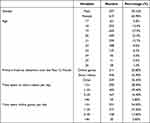 |
Table 1 General Demographic Data of the Subjects (n = 1016) |
Comparisons for Prospective and Retrospective Memory Questionnaire (PRM), Academic Delay of Gratification (ADOG), the Generalized Anxiety Disorder Scale (GAD-7), and Patient Health Questionnaire Scale (PHQ-9), Among the Different Internet Activity Groups
The 1016 participants were divided into three groups according to their primary Internet behaviors over the past 12 months. There were 211 (20.8%) participants was online games, and 446 (43.9%) participants was short videos. There were 359 (35.3%) participants other online behaviours included watching movies and television programs, reading online novels, and shopping. Both the online game and short video groups had worse PRM scores and ADOG scores than those of the other groups (Table 2).
 |
Table 2 Comparisons of the PRM, ADOG, Age and Gender Among the Different Internet Behaviors Groups (M ± SD) |
The percentage of college students with anxiety above the moderate level (GAD-7 ≥ 10) was 18.48% in online games group and 15.70% in short video group, both of which were higher than other online behaviors groups (14.76%).The percentage of college students with depression above the moderate level (PHQ-9 ≥ 10) was 26.07% in online games group and 23.32% in short video group, both of which were higher than other online behaviors groups (15.88%) (Table 3).
 |
Table 3 Estimation of the Level of Anxiety and Depression Among the Different Internet Behaviors Groups (n (%)) |
Comparison of the Generalized Anxiety Disorder Scale (GAD-7), Patient Health Questionnaire Scale (PHQ-9), Prospective and Retrospective Memory Questionnaire (PRM), and Academic Delay of Gratification (ADOG) Scores Among College Students with Different Short Video Usage Time or Online Game Usage Time
The results showed that with the extension of the time spent playing short videos/ online game, anxiety and depression tended to increase gradually, while PRM and ADOG tended to decrease gradually (p < 0.05 and p < 0.001; Table 4, Figures 1 and 2).
 |
Table 4 Comparisons of the GAD-7, PHQ-9, PRM and ADOG Scores Among the Different Short Video Usage Time Groups/ Online Game Usage Time. (M±SD) |
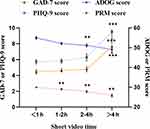 |
Figure 1 Trends of in the GAD-7, PHQ-9, PRMQ, and ADOG scores among different short video usage time groups. Notes: **P <0.01, ***P <0.001. |
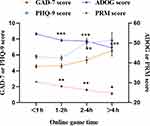 |
Figure 2 Trends in the GAD-7, PHQ-9, PRMQ, and ADOG scores among the different online gaming usage time groups. Notes: *P<0.05, **P <0.01, ***P <0.001. |
Correlation Analysis
The Spearman correlation analysis was used to analyze the correlations between GAD-7, PHQ-9, PRM, ADOG, time spent on short videos per day, and time spent online gaming per day. The results showed that there was a significant correlation between these variables (Table 5).The results showed that online games Time per day were positively correlated with short video Time per day, anxiety and depression, Time per day were negatively correlated with PRM and ADOG.
 |
Table 5 Correlation Analysis of the GAD-7, PHQ-9, PRM, ADOG, Time Spent Online Gaming per Day, and Time Spent on Short Videos per Day |
Mediation Model and Path Analysis
Common-Method Bias Test
Four scales (GAD-7, PHQ-9, PRM, and ADOG) were used to study the same group of subjects at the same time, therefore, the common-method bias due to the variation was accounted for. Harman’s single-factor test of common-method bias was applied to all the collected data in this study. The results showed that the initial eigenvalues of five factors were greater than 1 without rotation, while the variance explanation rate of the largest factor was 30.16% lower than the critical standard of 40%. Therefore, the data collected in this study conformed with the standard of the common-method bias test, and no multi-collinearity was estimated.
Chain Mediation Analysis
With gender and age as control variables, this study explored the intermediary role of depression/anxiety and prospective memory between time spent playing online games per day/time spent on short videos per day and ADOG. The deviation correction method, with 5000 bootstraps, was used to obtain a 95% confidence interval to test the significance of the effects. If the confidence interval did not contain 0, then the statistical result was considered to be significant. As shown in Tables 6 and 7, Figure 3, time spent playing online games per day/time spent on short videos per day had significant predictive effects on the GAD-7/PHQ-9, PRM, and ADOG. Moreover, GAD-7/PHQ-9 had significant predictive effects on PRM and ADOG, and PRM had significant predictive effects on ADOG. The mediating effects, direct effects, and corresponding effect scales are shown in Table 8, and they indicated that GAD-7/PHQ-9 and PRM play intermediary roles between time spent playing online games per day/time spent on short videos per day and ADOG (Figure 3).
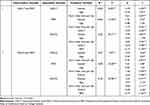 |
Table 6 The Chain-Mediation Analysis of the GAD-7/PHQ-9, PRM Between Time Spent on Short Videos per Day and ADOG |
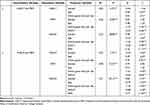 |
Table 7 The Chain-Mediation Analysis of the GAD-7/PHQ-9, PRM Between Time Spent Online Gaming per Day and ADOG |
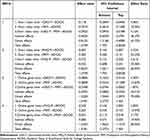 |
Table 8 The 95% Confidence Interval of the Mediating Effect Test and Deviation Corrections |
Discussion and Conclusions
Excessive Online Gaming and Short Video Behaviors Have a Bad Effect on ADOG
Since the WHO regarded gaming disorders as mental disorders in 2019, extensive research has been carried out on online gaming disorders.26–28 However, as short videos are a new internet phenomenon, there are still few studies on short video addiction. This study surveyed the major internet behaviors of 1016 college students in the past 12 months. It was found that the main online activity of 211 college students (20.8%) was playing online games and that of 446 college students (43.9%) was playing short videos. The results suggest that the proportion of Chinese college students who play short videos now may exceed that of those who play online games. Excessive short video behavior among college students is currently a highly noteworthy phenomenon.
Long-term reliance on online entertainment that provides short-term gratification, such as online games and short videos, may make it difficult to experience and implement work that should take more time and effort to achieve in college students. For instance, ADOG is the psychological tendency to delay immediate gratification or the impulse to pursue more valuable long-term learning goals.29 This study found that the online game and short video groups had lower prospective memory and ADOG scores than those of the other groups, and with the extension of the time spent playing online games or short videos, prospective memory and ADOG scores gradually decreased. This suggests that both excessive online gaming or short video behaviors may have a bad effect on prospective memory and ADOG.
Depression/Anxiety and Prospective Memory Played a Chain Intermediary Role Between Online Gaming Time per Day/ Short Videos Time per Day and ADOG
Excessive playing of online games and short videos has a bad effect on college students’ academic performance.7,8 Based on the mediation analysis, this study proposes that excessive playing of online games and short videos may lead to a decrease in ADOG in college students through anxiety/depression and prospective memory impairment.
Anxiety/Depression
This study showed that the percentage of college students with anxiety or depression above the moderate level (GAD-7 ≥ 10 or PHQ-9 ≥ 10) in online games group or short video group were higher than other online behaviors groups. This study also found that with the extension of the time spent playing online games or short videos, anxiety/depression gradually increased. This suggests that excessive gaming and short videos may lead to increased anxiety and depression. The mood disorders assessed with the scale are only preliminary screening results and their specificity needs to be further verified. However, the results of this study suggest that students who engage excessively in online games or short videos may have higher levels of anxiety and depression.
Anxiety/depression is a common negative emotion that is caused by excessive internet use, which is related to the withdrawal symptoms of addictive behavior.30 Anxiety/depression and other negative emotions can lead to a decline in the students’ learning confidence, physical discomfort, and the inability to concentrate on learning, thus, affecting ADOG ability.15
Previous studies have shown that negative emotions, such as anxiety and depression, impair future memory.31,32 Negative emotions disturb prospective memory, while positive emotions promote the performance of prospective memory.33 The reason why anxiety and depression impair long-term memory may be that negative emotions interfere with the allocation of cognitive resources. This means that you have to increase cognitive resources to cope with negative emotions and decrease cognitive resources for current tasks, which affects long-term memory.34
Prospective Memory
Prospective memory refers to the memory of future plans. After accepting the memory task, the memory of the future plan is in a state of subliminal activation, and it will be extracted and put into action at a specific time. In this process, individuals monitor the appearance of target clues through cognitive monitoring and timeously interrupt the influence of interfering factors to shift their attention to the prospective memory task.35 Because students who spend excessive time playing online games and short videos tend to satisfy their immediate impulses and pleasure and may have less self-control to realize future plans, they score lower in prospective memory. This study found that the online game and short video groups had lower prospective memory scores than those of the other groups, and with the extension of the time spent playing online games and short videos, prospective memory scores gradually decreased. This suggests that excessive gaming and short videos may lead to prospective memory impairment.Prospective memory is closely related to executive function, and executive functions are involved in prospective memory performance.36 They can also be used to predict prospective memory performance in adolescents.37 Studies of brain potentials38 and functional magnetic resonance39 have found that gaming disorders cause executive dysfunction through frontal lobe injury. Therefore, it can be speculated that excessive gaming and short videos may lead to prospective memory impairment through impairment of executive function.40 For example, some studies have found a correlation between addiction to video games and worse memory, attention, and cognitive and academic abilities.41
Although no current studies have found that prospective memory directly affects ADOG, some studies have confirmed that prospective memory may affect ADOG in other ways. For example, episodic future thinking is an effective way to counter impulsive behavior and decisions by adding weights to delayed benefits.42–44 Damage to the brain area that is responsible for episodic future thinking was found to affect the use of episodic future thinking in making more future-oriented decisions.45 Additionally, studies have found that future time insight is related to prospective memory and could predict the ability of ADOG46.These studies support the effect of prospective memory on ADOG. To sum up, it can be inferred that depression/anxiety and prospective memory may play an intermediary role between the excessive playing of online games or short videos and ADOG.
To the best of our knowledge, this is the first study that focuses on short videos and online games behaviors on college students’ ADOG, anxiety, depression, and prospective memory. These findings could be used as a basis for future studies on impact of excessive short video behaviors in the learning psychology. First, this study raised awareness that excessive short videos behaviour may produce the same psychological problems and learning problems as online gaming disorder. The problem of teenagers’ addiction to short videos is likely to become a major concern for education experts and the general public in the future. Secondly, this study also found that university students with excessive short video or online gaming behaviour have lower mental health than those with other online behaviours. Therefore, leaving online behaviour unchecked or unrestrained can have unintended negative consequences.47 In addiction, schools should provide appropriate psychological counselling for students to help them improve their mental health. This will help them improve their memory and academic performance in the future. Third, the results of this study provide a theoretical basis for increasing ADOG levels by improving prospective memory. Prospective memory requires cognitive flexibility in complex dynamic environments.48 Thus, improving cognitive flexibility can improve prospective memory and promote the ability to delay gratification.49 Whereas negative emotions such as anxiety and depression can reduce cognitive flexibility,50,51 and subjects with excessive internet use behaviors also show impaired cognitive flexibilities,52 which leads to decreased prospective memory. This provides a way to improve prospective memory and ADOG through psychotherapy.
There are also limitations to this study that should be mentioned. First, this study was a cross-sectional study, and the causal relationship between the variables cannot be determined. Thus, subsequent experimental research is needed to further verify the hypothesis of the intermediary analysis. Second, there may be other variables affecting ADOG that were not included in this study. Third, the data of this study was based on the subjective self-assessment scale, which may lead to bias. Therefore, future research should include a combination of multiple objective evaluation methods to improve the accuracy of the conclusions. Fourth, short videos are a new medium, and there is currently no scale to measure short video addiction, which should be developed in future studies.
Data Sharing Statement
The original contributions presented in the study are included in the article, further inquiries can be directed to the corresponding author.
Ethics Statement
According to the Declaration of Helsinki, the study was conducted with the approval of the Ethics Committee of Bengbu Medical College. The patients/participants provided their written informed consent to participate in this study.
Funding
This project was supported by the Health Research key Project of Anhui Province (AHWJ2022a029) Bengbu Medical College key Laboratory of Addiction Medicine 29-3. Bengbu Medical College’s innovative training Program for postgraduate students (Byycx22086, Byycx22020). Innovative training Program for Chinese College students (S202210368092, 202210367035). Anhui Provincial graduate Student Innovation and Entrepreneurship practice Project (2022cxcysj176). Anhui Provincial Education Department Humanities and Social Science Key Project (SK2021A0430).Natural Science Key Project of Anhui Provincial Department of Education (2023AH051971).All funders didn’t interfere in study design, collection, analysis, interpretation or writing of manuscript.
Disclosure
The authors state that the study was conducted without any business or financial relationships that could be considered a potential conflict of interest.
References
1. Wong HY, Mo HY, Potenza MN, et al. Relationships between severity of internet gaming disorder, severity of problematic social media use, sleep quality and psychological distress. Int J Environ Res Public Health. 2020;17(6):1879. doi:10.3390/ijerph17061879
2. Weinstein A, Lejoyeux M. Internet addiction or excessive internet use. Am J Drug Alcohol Abuse. 2010;36(5).
3. Bauernhofer K, Papousek I, Fink A, et al. Internetnutzungsverhalten (PIN)--eine Übersicht zu Messinstrumenten und Risikofaktoren [Problematic internet use (PIN)--A review of assessment questionnaires and risk factors]. Neuropsychiatr. 2016;30(1):2–9. German. doi:10.1007/s40211-015-0169-3
4. Pocai B. The ICD-11 has been adopted by the world health assembly. World Psychiat. 2019;18(3):371–372. doi:10.1002/wps.20689
5. Purnomo A, Wibowo AE, Kurniawan K, et al. The relationship between smartphone addiction, academic burnout and academic procrastination among university students during online learning. PSIKOPEDAGOGIA J Bimb Dan Konsel. 2020;9(2):81. doi:10.12928/psikopedagogia.v9i2.17966
6. Cnnic. The 51th statistical report on China’s internet development[EB/OL]; 2023. Available from: https://www.cnnic.net.cn/n4/2023/0303/c88-10757.html.
7. She R, Wong K, Lin J, et al. How COVID-19 stress related to schooling and online learning affects adolescent depression and Internet gaming disorder: testing conservation of resources theory with sex difference. J Behav Addict. 2021;10(4):953–966.
8. Ye JH, Wu YT, Wu YF, et al. Effects of short video addiction on the motivation and well-being of Chinese vocational college students. Front Public Health. 2022;10:847672. doi:10.3389/fpubh.2022.847672
9. Bembenutty H. Sustaining motivation and academic goals: the role of academic delay of gratification. Learn Individ Differ. 1999;11(3):233–257. doi:10.1016/S1041-6080(99)80002-8
10. Bembenutty H, Mckeachie WJ, Karabenick SA, et al. Teaching effectiveness and course evaluation: the role of academic delay of gratification. Coll Stud. 2001;2001:33.
11. Bembenutty H. Academic delay of gratification and self-efficacy enhance academic achievement among minority college students. Acad Achie. 2002;2002:31.
12. Anokhin AP, Golosheykin S, Grant JD, et al. Heritability of delay discounting in adolescence: a longitudinal twin study. Behav Genet. 2011;41(2):175–183. doi:10.1007/s10519-010-9384-7
13. Jun-Qing E. An overview of researches on delay of gratification; 2007.
14. Gros L, Debue N, Lete J, et al. Video game addiction and emotional states: possible confusion between pleasure and happiness? Front Psychol. 2020;10:2894. doi:10.3389/fpsyg.2019.02894
15. Jiao CY, Song X, Shao WY, et al. The chain-mediation pathway of gender regarding academic delay of gratification in college students is regulated by anxiety/depressive mood and prospective memory. Front Psychol. 2022;13:1015331. doi:10.3389/fpsyg.2022.1015331
16. Zhou FC, Wang YY, Zheng W, et al. Prospective memory deficits in patients with depression: a meta-analysis. J Affect Disord. 2017;220:79–85. doi:10.1016/j.jad.2017.05.042
17. Brandimonte MA, Einstein GO, Mcdaniel MA. Prospective Memory: Theory and Applications. Psychology Press; 2014.
18. Beran MJ, Menzel CR, Parrish AE, et al. Primate cognition: attention, episodic memory, prospective memory, self-control, and metacognition as examples of cognitive control in nonhuman primates. Wiley Interdiscip Rev Cogn Sci. 2016;7(5):294–316. doi:10.1002/wcs.1397
19. Johnson SU, Ulvenes V, Øktedalen T, et al. Psychometric properties of the general anxiety disorder 7-item (GAD-7) scale in a heterogeneous psychiatric sample. Front Psychol. 2019;10:1713. doi:10.3389/fpsyg.2019.01713
20. Spitzer RL, Kroenke K, Williams JB, et al. A brief measure for assessing generalized anxiety disorder: the GAD-7. Arch Intern Med. 2006;166(10):1092–1097. doi:10.1001/archinte.166.10.1092
21. Wang W, Bian Q, Zhao Y, et al. Reliability and validity of the Chinese version of the Patient Health Questionnaire (PHQ-9) in the general population. Gen Hosp Psychiatry. 2014;36(5):539–544. doi:10.1016/j.genhosppsych.2014.05.021
22. Zhang YL, Liang W, Chen ZM, et al. Validity and reliability of patient health questionnaire-9 and patient health questionnaire-2 to screen for depression among college students in China. Asia Pac Psychiatry. 2013;5(4):268–275. doi:10.1111/appy.12103
23. Spitzer RL, Kroenke K, Williams JB. Validation and utility of a self-report version of PRIME-MD: the PHQ primary care study. PRIM Care Evalua Ment Dis Patient Health Quest Jama. 1999;282(18):1737–1744.
24. Yang TX, Wang Y, Wang Y, et al. Validity and normative data of the Chinese prospective and retrospective memory questionnaire (PRMQ) across adolescence, adults and elderly people. Memory. 2022;30(3):344–353. doi:10.1080/09658211.2021.2014526
25. King R, Du H. All good things come to those who wait: validating the Chinese version of the Academic Delay of Gratification Scale (ADOGS). Inter J Educ Psychol Assess. 2011;7(1):64–80.
26. Dong G, Wang L, Du X, et al. Gender-related differences in neural responses to gaming cues before and after gaming: implications for gender-specific vulnerabilities to Internet gaming disorder. Soc Cogn Affect Neurosci. 2018;13(11):1203–1214. doi:10.1093/scan/nsy084
27. Jeong H, Yim HW, Lee SY, et al. Discordance between self-report and clinical diagnosis of Internet gaming disorder in adolescents. Sci Rep. 2018;8(1):10084. doi:10.1038/s41598-018-28478-8
28. Snodgrass JG, Lacy MG, Cole SW. Internet gaming, embodied distress, and psychosocial well-being: a syndemic-syndaimonic continuum. Soc Sci Med. 2022;295:112728. doi:10.1016/j.socscimed.2019.112728
29. Bembenutty H, Karabenick SA. Inherent association between academic delay of gratification, future time perspective, and self-regulated learning. Educ Psychol Rev. 2004;16(1):35–57. doi:10.1023/B:EDPR.0000012344.34008.5c
30. Labana RV, Hadjisaid JL, Imperial AR, et al. Online game addiction and the level of depression among adolescents in Manila, Philippines. Cent Asian J Glob Health. 2020;9(1):e369. doi:10.5195/cajgh.2020.369
31. Harris LM, Cumming SR. An examination of the relationship between anxiety and performance on prospective and retrospective memory tasks. Aust J Psychol. 2003;55(1):51–55. doi:10.1080/00049530412331312874
32. Schnitzspahn KM, Thorley C, Phillips L, et al. Mood impairs time-based prospective memory in young but not older adults: the mediating role of attentional control. Psychol Aging. 2014;29(2):264–270. doi:10.1037/a0036389
33. Harris LM, Menzies RG. Mood and prospective memory. Memory. 1999;7(1):117–127. doi:10.1080/741943717
34. Xian J, Wang Y, Han B. Effect of emotion on prospective memory in those of different age groups. Comput Intell Neurosci. 2020;2020:8859231. doi:10.1155/2020/8859231
35. Matos P, Albuquerque PB. From retrospective to prospective memory research: a framework for investigating the deactivation of intentions. Cogn Process. 2021;22(3):411–434. doi:10.1007/s10339-021-01016-7
36. Mioni G, Stablum F, Mcclintock SM, et al. Time-based prospective memory in severe traumatic brain injury patients: the involvement of executive functions and time perception. J Int Neuropsychol Soc. 2012;18(4):697–705. doi:10.1017/S1355617712000306
37. Altgassen M, Vetter V, Phillips LH, et al. Theory of mind and switching predict prospective memory performance in adolescents. J Exp Child Psychol. 2014;127:163–175. doi:10.1016/j.jecp.2014.03.009
38. Kim J, Park J, Park YM, et al. Diminished frontal theta activity during gaming in young adults with internet gaming disorder. Front Neurosci. 2019;13:1183. doi:10.3389/fnins.2019.01183
39. Wang Y, Yin Y, Sun YW, et al. Decreased prefrontal lobe interhemispheric functional connectivity in adolescents with internet gaming disorder: a primary study using resting-state FMRI. PLoS One. 2015;10(3):e0118733. doi:10.1371/journal.pone.0118733
40. Zhao W, Wei T, Zhou R, et al. The influence of online game behaviors on the emotional state and executive function of college students in China. Front Psychiatry. 2021;12:713364. doi:10.3389/fpsyt.2021.713364
41. Farchakh Y, Haddad C, Sacre H, et al. Video gaming addiction and its association with memory, attention and learning skills in Lebanese children. Child Adolesc Psychiatry Ment Health. 2020;14(1):46. doi:10.1186/s13034-020-00353-3
42. Benoit RG, Gilbert SJ, Burgess PW. A neural mechanism mediating the impact of episodic prospection on farsighted decisions. J Neurosci. 2011;31(18):6771–6779. doi:10.1523/JNEUROSCI.6559-10.2011
43. Daniel TO, Stanton CM, Epstein LH. The future is now: reducing impulsivity and energy intake using episodic future thinking. Psychol Sci. 2013;24(11):2339–2342. doi:10.1177/0956797613488780
44. Peters J, Büchel C. Episodic future thinking reduces reward delay discounting through an enhancement of prefrontal-mediotemporal interactions. Neuron. 2010;66(1):138–148. doi:10.1016/j.neuron.2010.03.026
45. Palombo DJ, Keane MM, Verfaellie M. The medial temporal lobes are critical for reward-based decision making under conditions that promote episodic future thinking. Hippocampus. 2015;25(3):345–353. doi:10.1002/hipo.22376
46. Zhuang Y. Research into the relationship between college students’ future time insight and academic delay of gratification. Theor Pract Educ. 2011;31(1):42–45.
47. Chen CY, Chen IH, O’brien KS, et al. Psychological distress and internet-related behaviors between schoolchildren with and without overweight during the COVID-19 outbreak. Int J Obes. 2021;45(3):677–686. doi:10.1038/s41366-021-00741-5
48. Boag RJ, Strickland L, Heathcote A, et al. Cognitive control and capacity for prospective memory in complex dynamic environments. J Exp Psychol Gen. 2019;148(12):2181–2206. doi:10.1037/xge0000599
49. Koslov SR, Mukerji A, Hedgpeth KR, et al. Cognitive flexibility improves memory for delayed intentions. eNeuro. 2019;6(6):250. doi:10.1523/ENEURO.0250-19.2019
50. Hsieh S, Lin SJ. The dissociable effects of induced positive and negative moods on cognitive flexibility. Sci Rep. 2019;9(1):1126. doi:10.1038/s41598-018-37683-4
51. Park J, Moghaddam B. Impact of anxiety on prefrontal cortex encoding of cognitive flexibility. Neuroscience. 2017;345:193–202. doi:10.1016/j.neuroscience.2016.06.013
52. Dong G, Lin X, Zhou H, et al. Cognitive flexibility in internet addicts: fMRI evidence from difficult-to-easy and easy-to-difficult switching situations. Addict Behav. 2014;39(3):677–683. doi:10.1016/j.addbeh.2013.11.028
 © 2023 The Author(s). This work is published and licensed by Dove Medical Press Limited. The full terms of this license are available at https://www.dovepress.com/terms.php and incorporate the Creative Commons Attribution - Non Commercial (unported, v3.0) License.
By accessing the work you hereby accept the Terms. Non-commercial uses of the work are permitted without any further permission from Dove Medical Press Limited, provided the work is properly attributed. For permission for commercial use of this work, please see paragraphs 4.2 and 5 of our Terms.
© 2023 The Author(s). This work is published and licensed by Dove Medical Press Limited. The full terms of this license are available at https://www.dovepress.com/terms.php and incorporate the Creative Commons Attribution - Non Commercial (unported, v3.0) License.
By accessing the work you hereby accept the Terms. Non-commercial uses of the work are permitted without any further permission from Dove Medical Press Limited, provided the work is properly attributed. For permission for commercial use of this work, please see paragraphs 4.2 and 5 of our Terms.

